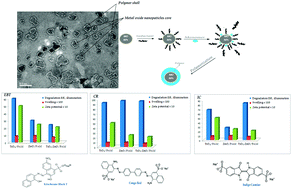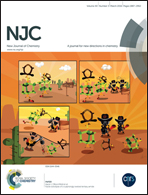Superabsorbent enhanced-catalytic core/shell nanocomposites hydrogels for efficient water decolorization†
Abstract
Spherical polyacrylamide (PAM) nanoparticles were prepared by inverse emulsion polymerization and were found to have an average particle size of 20 nm. In situ inverse emulsion polymerization of acrylamide in the presence of metal oxides nanoparticles (TiO2 and ZnO, either individually or in a mixture) was performed. Transmission electron microscope images clearly confirmed the formation of core/shell nanocomposite structures with inner metal oxide cores coated with a polyacrylamide shell. The composites were further cross-linked to prevent structural deformation in water. The water absorbencies of the prepared composites were 1660, 900, 1000 and 700% for PAM, TiO2/PAM, ZnO/PAM, and TiO2–ZnO/PAM core/shell nanocomposites, respectively. The water decontamination efficiency of the prepared composites was investigated using organic dyes as models of organic contaminants. The decolorization efficiency of the prepared composites was investigated in the dark and under illumination. The nanocomposites showed good ability for photodecolorization, especially the titania nanocomposite, which showed the best ability to photodecolorize Black T and Indigo dyes. A synergetic effect between the adsorption properties of the polymer and the photocatalytic activity of the metal oxides is proposed.



 Please wait while we load your content...
Please wait while we load your content...